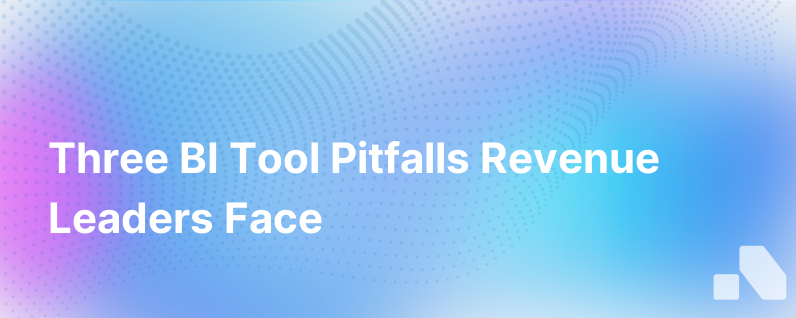The 3 Ways Bi Tools Fail Revenue Leaders
Published on January 1, 2024 by Sawyer Middeleer
In an era dominated by data-driven decisions, business intelligence (BI) tools have become the lifeline for organizations striving to unearth actionable insights from their vast data reserves. These tools are sought after for their promise of delivering a clear line of sight into business operations and customer behaviors – offering revenue leaders the intelligence they need to drive growth.
Yet, despite their sophistication and potential, BI tools often fall short of the high expectations placed upon them, particularly when it comes to revenue leadership and its unique set of requirements. In exploring the pitfalls endemic to the use of BI tools, we'll dissect three significant ways they fail revenue leaders, who hinge upon precise, actionable intel to craft winning strategies and spur organizational success.
1. Overemphasis on Descriptive Analytics
BI tools excel at aggregating massive datasets to present a descriptive view of what has happened in the past – they churn out historical reports and dashboards that detail past performance. Although understanding the past is foundational, it does little to illuminate the path forward. Revenue leaders need forward-looking, predictive analytics that can not only contextualize past events but also anticipate future trends and outcomes.
The Disconnect:
- Descriptive analytics dominate the functionalities of many BI tools, leaving a gap in predictive capabilities that are crucial for revenue forecasting and scenario planning.
- The static nature of reports often misses the dynamic, fast-paced decision-making environment that revenue leaders operate in.
What's Needed:
- An evolution towards more advanced predictive and prescriptive analytics that can feed into revenue projections and strategic planning processes.
- Real-time, dynamic analytics that adapt to emerging data for sales pipeline management and revenue adjustments.
2. Insufficient Integration with Sales and Marketing Data
Revenue growth is inherently tied to the effectiveness of sales and marketing efforts, which in turn are linked to a myriad of platforms and data sources – CRM systems, email marketing software, social media analytics, and more. In an ideal world, BI tools would seamlessly integrate with these disparate systems, painting a comprehensive picture of the sales funnel. Yet, the reality is one characterized by integration challenges and siloed data.
The Hurdle:
- Integration with critical sales and marketing platforms can be clunky at best and non-existent at worst, complicating the user experience and compromising data accuracy.
- Siloed insights prevent a 360-degree view of the customer journey, which is pivotal for personalizing engagement and optimizing conversion rates.
The Ideal Solution:
- Robust, native integrations with key sales and marketing tools that provide a unified view of customer interactions and touchpoints.
- A streamlined flow of data that ensures consistency and reliability of the insights gathered, enabling better strategic decisions.
3. Lack of Personalized and Actionable Insights
Data is only as good as the action it inspires. BI tools often churn out generic insights that, while interesting, do not directly translate into actionable strategies for specific business contexts. Revenue leaders are left yearning for more nuanced intelligence – insights that are not only tailored to their business model, customer base, and market dynamics but also accompanied by actionable recommendations.
The Shortfall:
- One-size-fits-all reports that sweep over the unique nuances of an organization's specific market position and revenue challenges.
- A dearth of actionable recommendations that directly address the strategic needs of revenue leaders in driving sales growth.
The Desired Features:
- Advanced segmentation and filter capabilities that allow revenue leaders to distill insights pertinent to specific products, regions, or customer segments.
- Actionable intelligence that not only flags areas of concern or opportunity but also prescribes potential courses of action.
Bridging the Gap with Aomni
While traditional BI tools are fraught with these shortcomings, the emergence of intelligent platforms such as Aomni heralds a new dawn for revenue leaders. Aomni transcends the mere presentation of past data, it embodies the predictive and prescriptive future of data analytics.
- Predictive Excellence: Aomni leverages advanced machine learning algorithms to deliver predictive insights that empower revenue leaders to anticipate market shifts and customer needs.
- Seamless Integration: With its capability to natively sync with a multitude of sales and marketing platforms, Aomni breaks down the barriers of data silos, presenting a holistic view of the sales funnel.
- Custom-tailored Actions: Beyond generic insights, Aomni specializes in personalized and actionable recommendations tailored to the unique contours of your business landscape.
In essence, Aomni not only identifies the pitfalls that hinder BI tools from effectively serving revenue leaders but fills those very gaps. The future of BI is not just about vast data analysis – it's about intelligent, predictive, and actionable insights that chart a clear course for revenue acceleration. Aomni stands at the forefront of this evolution, redefining how revenue leaders interact with, interpret, and act upon their data.